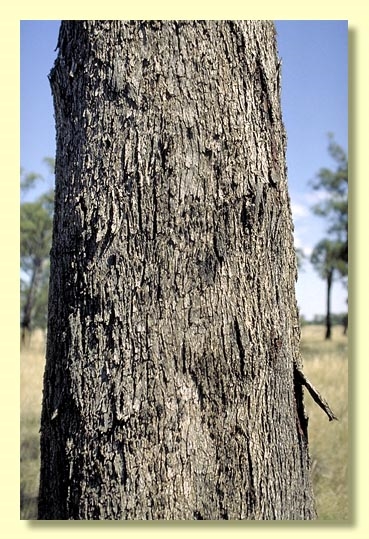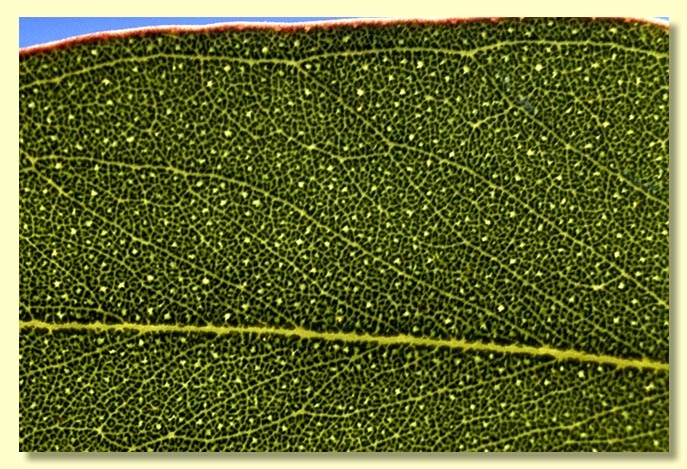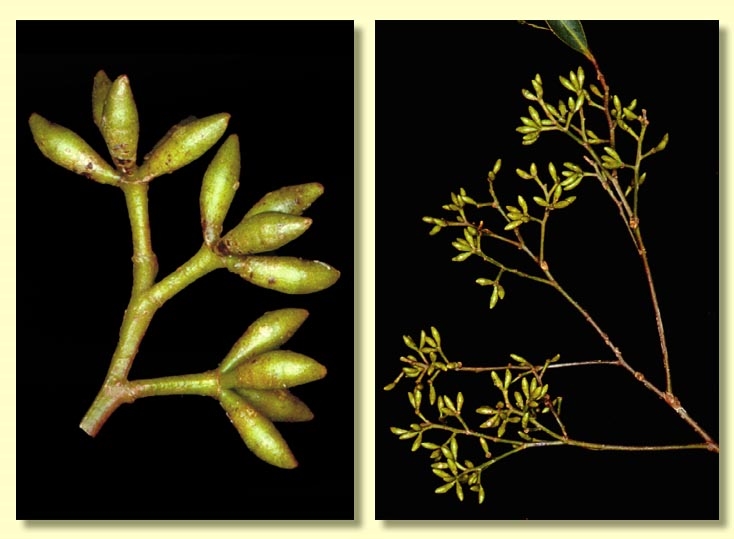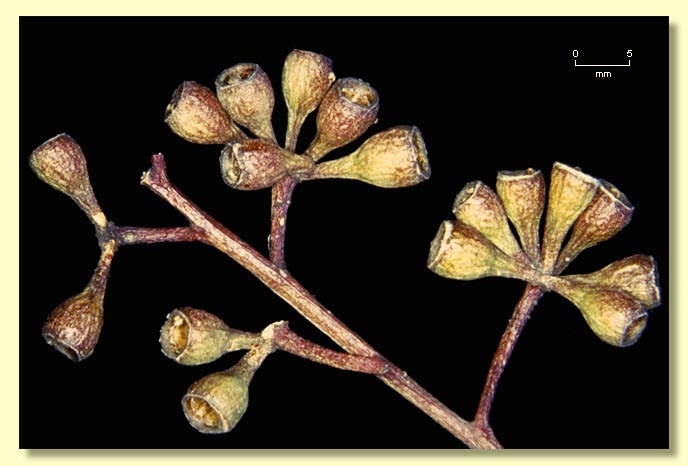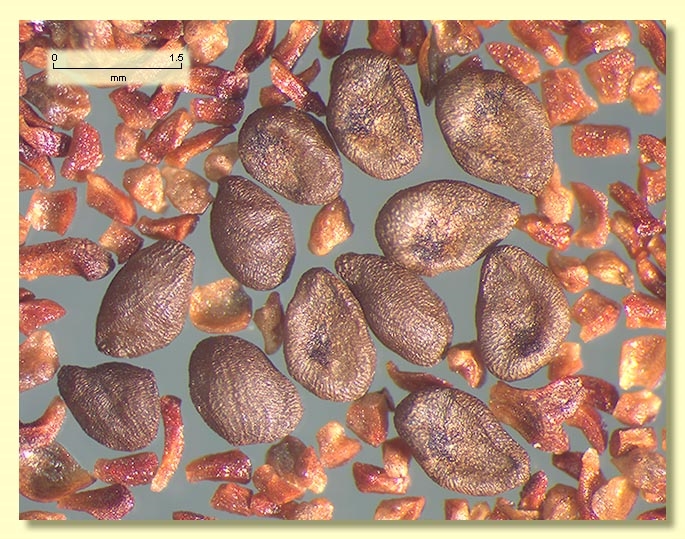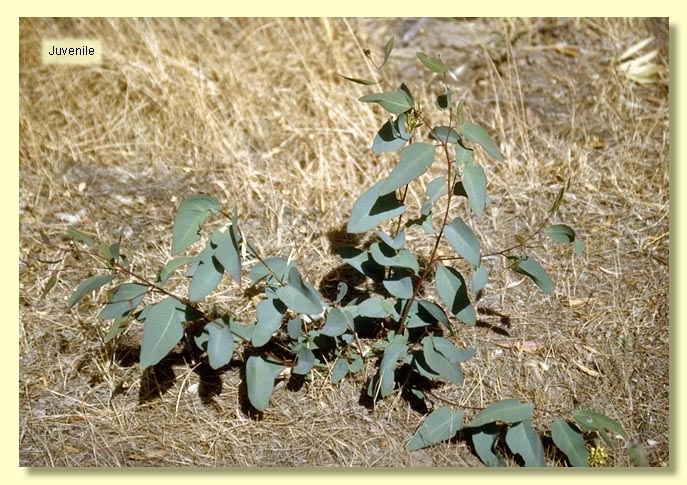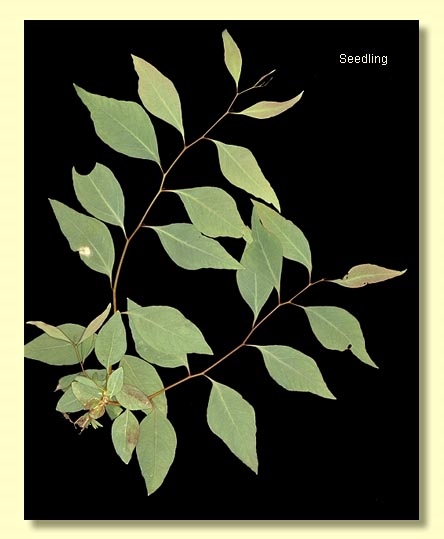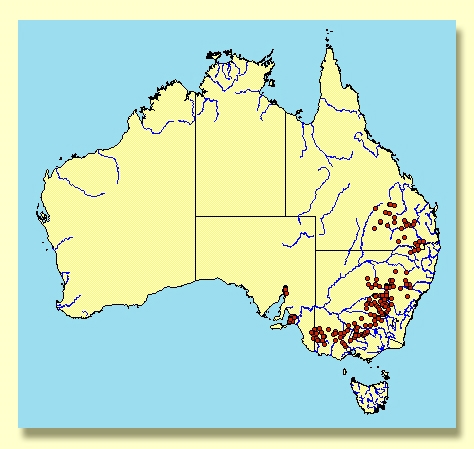Euclid - Online edition
Eucalyptus microcarpa
Eucalyptus | Symphyomyrtus | Adnataria | Apicales | Buxeales | Continentes
Bark rough over whole trunk and to base of larger branches, box-type or tessellated, grey, grey- brown or mottled with grey and whitish patches; smooth bark usually white; pith of branchlets sometimes glandular.
Juvenile growth (coppice or field seedlings to 50 cm): stem rounded in cross-section; juvenile leaves always petiolate, opposite for a few pairs then alternate, ovate, 6–15 cm long, 3–5.5 cm wide, dull, blue-green or green.
Adult leaves alternate, petiole 0.5–2 cm long; blade lanceolate, 6–15 cm long, 1–3 cm wide, glossy or dull, green, side-veins acute, densely reticulate, intramarginal vein parallel to and well removed from margin, oil glands mostly intersectional.
Inflorescence terminal compound, and sometimes compound in subterminal axils also, peduncles 0.3–1 cm long, buds usually 7 per umbel, pedicels 0.1–0.4 cm long. Mature buds ovoid to fusiform to diamond-shaped, 0.5–0.9 cm long, 0.2–0.4 cm wide, green to yellow, scar absent, operculum conical to beaked, stamens irregularly flexed, anthers adnate, globoid, dehiscing by small lateral or subterminal pores, style long, stigma blunt or pin-head shaped, locules 3 or 4, the placentae each with 4 vertical ovule rows. Flowers white.
Fruit sessile or with pedicels to 0.5 cm long, cup-shaped to cylindrical or barrel-shaped, 0.3–0.9 cm long, 0.3–0.5 cm wide, sometimes faintly angled longitudinally, disc descending, valves 3 or 4, near rim level or enclosed.
Seeds black, brown or grey, 1–2 mm long, flattened-ovoid, often pointed at one end, dorsal surface shallowly pitted, hilum ventral.
Cultivated seedlings (measured at ca node 10): cotyledons reniform to oblong; stems rounded or square in cross-section; leaves petiolate, opposite for 3 to 6 pairs then alternate, ovate-lanceolate, 4–9 cm long, 2–5 cm wide, base tapering, margin entire, apex pointed, dull, blue-green to green.
Flowering has been recorded in February, March, May and June.
A small to medium-sized box tree widespread on the drier side of the Dividing Range in south-eastern Australia from the Bordertown area of south-east South Australia east through Victoria and the western slopes and plains of New South Wales into south-eastern Queensland as far as Bollon and Charleville; there is a disjunct occurrence from Melrose to the Adelaide Plains in South Australia. In Queensland it grades to the north into the larger-leaved E. moluccana, and on the Darling Downs with E. woollsiana.
Plants of E. woollsiana have narrower juvenile and adult leaves whilst E. moluccana has broader ovate juvenile leaves and less rough bark on the trunks. Another closely related species, E. albens, has longer, usually glaucous buds and a dull bluish to glaucous-leaved crown whilst the more coastally distributed E. moluccana has less extensive rough bark and coarser leaves, buds and fruit. In South Australia it may be confused with E. odorata, which is a smaller tree or mallee with new leaf growth blue-green maturing glossy green and axillary inflorescences. In the Bordertown area of South Australia and adjacent areas of Victoria from Yanac to Lillimur South, intergrades between E. microcarpa and E. odorata occur. These are depauperate trees described in 1994 as E. silvestris Rule. This taxon is not recognised as a distinct species in EUCLID.
In eastern and central parts of its Victorian distribution (e.g. Maryborough, Greytown State Forest, Benalla) E. microcarpa intergrades with E. albens and populations with some attributes of both species occur. Similar populations occur in New South Wales around Holbrook to Wagga Wagga.
Eucalyptus microcarpa belongs in Eucalyptus subgenus Symphyomyrtus section Adnataria (the boxes) because the buds have two opercula, ovules are in four rows, seeds are flattened-ovoid, cotyledons are reniform, and anthers are rigid on the staminal filaments. Within section Adnataria, E. microcarpa is part of a subgroup, series Buxeales subseries Continentes, further distinguished by having buds that retain the outer operculum until flowering time when both opercula are shed together. Most species in this group are from eastern Australia and have all stamens fertile and are woodland trees of hills and plains, often dominant in the landscape, viz. E. albens, E. moluccana, E. microcarpa and E. woollsiana. Others, viz. E. viridis, E. polybractea, E. froggattii, E. odorata, E. albopurpurea and E. porosa, are mallees, some of them also occurring as small trees occasionally.
The closely related species E. moluccana, E. microcarpa and E. woollsiana differ mainly in the size of the juvenile leaves, other dimensions being overlapping to some degree:
Fruit
l x w cm
Adult leaves
l x w cm
Juvenile leaves
l x w cm
Juvenile leaves
l:w ratio range
woollsiana
0.2-0.4 x 0.2-0.4
7.5-13.5 x 0.6-1.5
6-15 x 0.3-1.5
(6)10-20
microcarpa
0.3-0.9 x 0.3-0.5
6-15 x 1-3
6-15 x 3-5.5
2-3
moluccana
0.3-0.7 x 0.3-0.6
7-17 x 1.5-6.5
4-8 x 2.5-5.5
1.5-2
Based on specimens at CANB
Not all specimens of E. microcarpa and E. woollsiana will be easily identified and, without juvenile leaves, may be impossible to assign to one name or the other. The southern distributional limits of E. woollsiana into the NSW South-west Plains region as far south as Ardlethan and Narrandera is asserted by Bean (2009) but questioned here in EUCLID. Botanists wishing to identify specimens with certainty will need make careful field collections including notes on habitat and local variation between trees; seed collection is usually easy and growing of seedlings for additional juvenile data will aid identificarion with juvenile leaf length: width raitos being the best guide - if using seedlings make this measurement higher than the point where seedling leaves cease to be opposite on the stem i.e. have become alternate.


